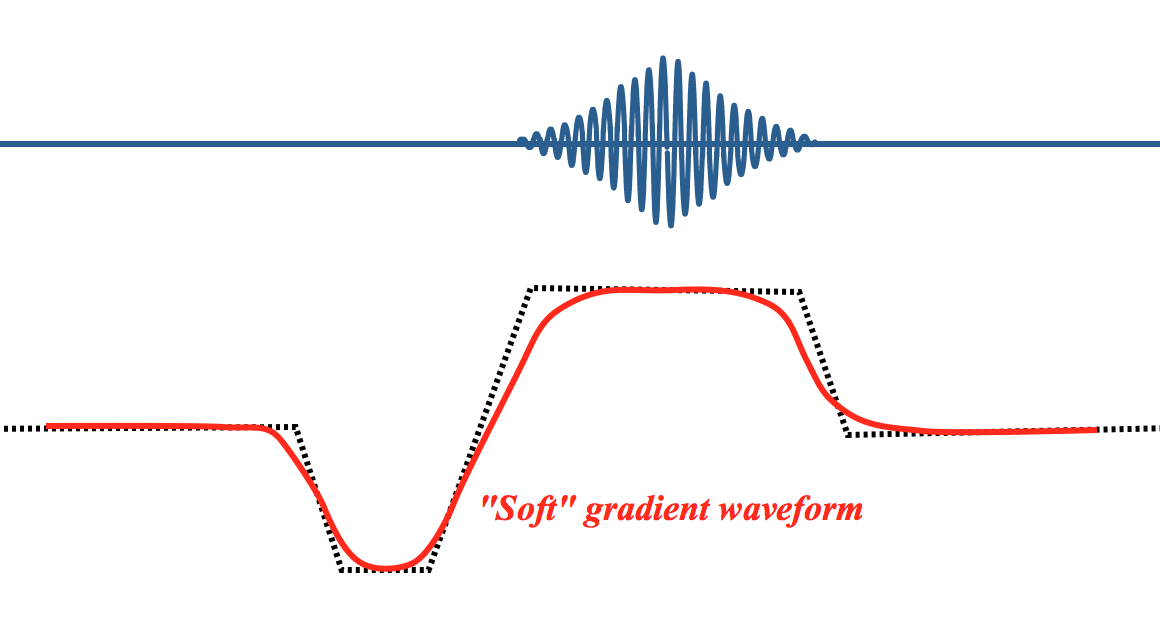Superconductive scanners all have a refrigeration system including a pump for liquid helium. This pump creates a relatively quiet, low-frequency, rhythmic "thump-thump" background noise that is present whether or not a scan is being performed.
|
00:00 00:00 00:00 Background helium pump noise 00:00 00:00 00:00 Gradient noise: Fast spin echo 00:00 00:00 00:00 Gradient noise: Diffusion 00:00 00:00 00:00 Gradient noise: Echo-planar (loudest) |
Much louder noises occur during scanning from vibrations of gradient coils as rapidly switched electrical currents pass through them. These vibrations may be radiated into the air as sound waves or transmitted by physical linages to other parts of the building. Each pulse sequence produces a characteristic noise pattern based on its gradient waveforms. Echo-planar sequences are typically the loudest, producing sound pressures in the range of 110-120 dB. This "jackhammer" level of noise may create patient discomfort, and anxiety, and even temporary hearing loss. Providing patients with ear plugs or headphones during scanning is therefore mandatory.
|
Mechanical methods to reduce noise transmission include: use of acoustic wall, floor and ceiling tiles; true double wall construction with separate unconnected studs; placing absorptive material (fiberglass) between the studs; sealing wall junctions with acoustic caulking; offsetting the drywall seams; lining air ducts with absorbent material and installing intermittent baffles; assuring doors and windows are tight-fitting; sealing areas around penetration panels and pipes; and installing a vibration pad between the magnet and the floor. Canon has introduced a gradient design (called Pianissimo™) in which the gradients are enclosed in a vacuum chamber and mounted on a support that separates the gradient coil from the magnet structure. Other vendors have made manufacturing changes such as more tightly binding the gradient coil layers with resin to reduce vibrations.
|
Recently the major MR vendors have released low-noise imaging software package known as SilentScan (GE), QuietX (Siemens), and ComforTone (Philips). These low-noise sequences have similar structures to conventional ones, but utilize "gentler" gradient waveforms with more gradual ramp-up and ramp-down times. These methods reduce scanner noise to within 10 dB of background but carry an approximately 10% signal-to-noise penalty as a result of shorter available windows for data sampling.
|
00:00 00:00 00:00 Comparison of conventional TSE v 'quiet' TSE noise levels |
To achieve nearly complete gradient silence, a completely different type of pulse sequence is required. The GE and Siemens strategies are similar, employing 3D ultrashort ("zero") TE methods. Known as Silenz and PETRA, these techniques are described more completely in the Advanced Techniques: Ultrashort TE section.
Advanced Discussion (show/hide)»
No supplementary material yet. Check back soon!
References
ETS-Lindgren. Acoustic shielding solutions for MRI installations. 2009.
Edelstein WA, Hedeen RA, Mallozzi RP et al. Making MRI quieter. Magn Reson imaging 2002; 20:155-163.
Hennel F, Girard F, Loenneker T. "Silent" MRI with soft gradient pulses. Magn Reson Med 1999; 42:6-10.
Heismann B, Ott M, Grodzki D. Sequence-based acoustic noise reduction of clinical MRI scans. Magn Reson Med 2015; 73:1104-1109.
Pierre EY, Grodzki D, Heisman B, et al. Making MRI scanning quieter: optimized TSE sequences with parallel imaging. MAGNETOM Flash 2013; 5:30-34.
ETS-Lindgren. Acoustic shielding solutions for MRI installations. 2009.
Edelstein WA, Hedeen RA, Mallozzi RP et al. Making MRI quieter. Magn Reson imaging 2002; 20:155-163.
Hennel F, Girard F, Loenneker T. "Silent" MRI with soft gradient pulses. Magn Reson Med 1999; 42:6-10.
Heismann B, Ott M, Grodzki D. Sequence-based acoustic noise reduction of clinical MRI scans. Magn Reson Med 2015; 73:1104-1109.
Pierre EY, Grodzki D, Heisman B, et al. Making MRI scanning quieter: optimized TSE sequences with parallel imaging. MAGNETOM Flash 2013; 5:30-34.
Related Questions
What are gradient coils?
What are gradient coils?

